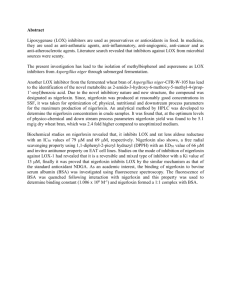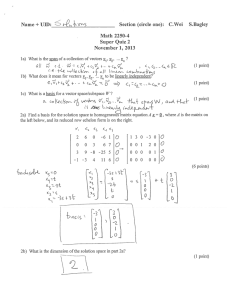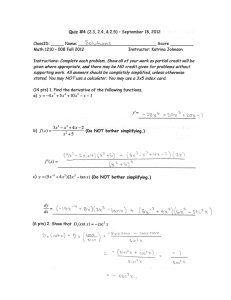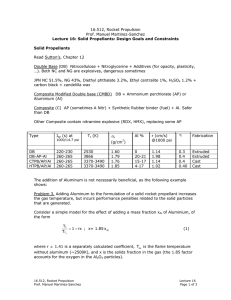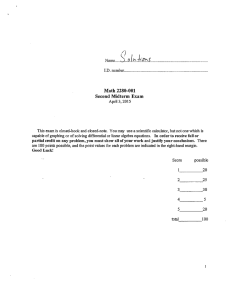16.512, Rocket Propulsion Prof. Manuel Martinez-Sanchez
advertisement
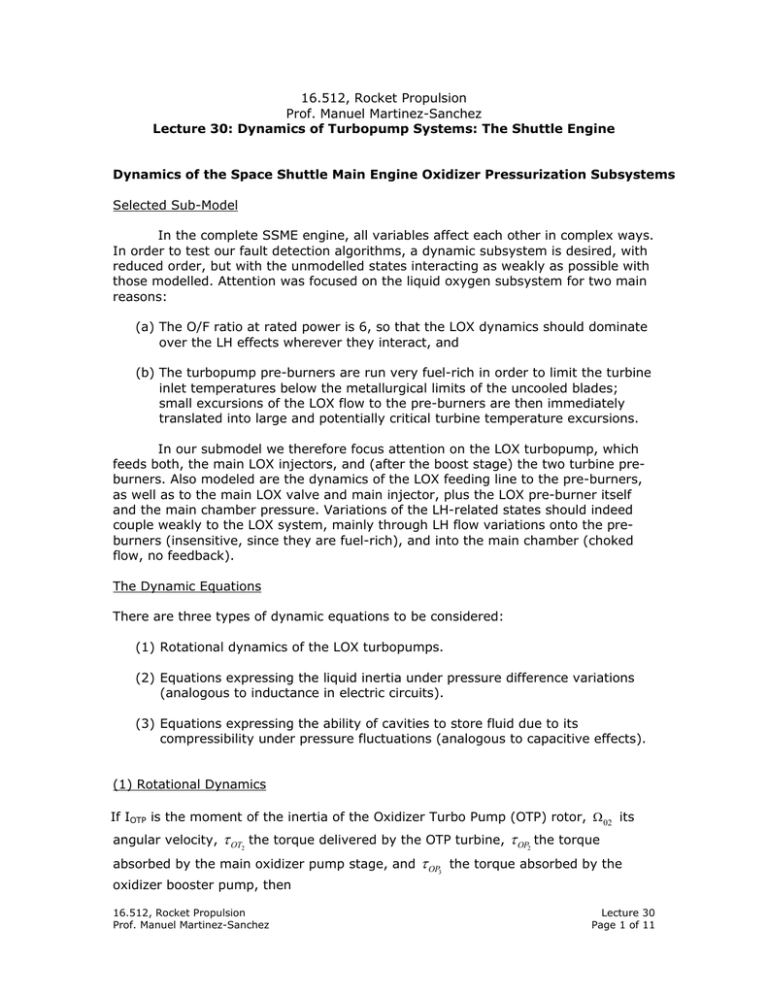
16.512, Rocket Propulsion Prof. Manuel Martinez-Sanchez Lecture 30: Dynamics of Turbopump Systems: The Shuttle Engine Dynamics of the Space Shuttle Main Engine Oxidizer Pressurization Subsystems Selected Sub-Model In the complete SSME engine, all variables affect each other in complex ways. In order to test our fault detection algorithms, a dynamic subsystem is desired, with reduced order, but with the unmodelled states interacting as weakly as possible with those modelled. Attention was focused on the liquid oxygen subsystem for two main reasons: (a) The O/F ratio at rated power is 6, so that the LOX dynamics should dominate over the LH effects wherever they interact, and (b) The turbopump pre-burners are run very fuel-rich in order to limit the turbine inlet temperatures below the metallurgical limits of the uncooled blades; small excursions of the LOX flow to the pre-burners are then immediately translated into large and potentially critical turbine temperature excursions. In our submodel we therefore focus attention on the LOX turbopump, which feeds both, the main LOX injectors, and (after the boost stage) the two turbine preburners. Also modeled are the dynamics of the LOX feeding line to the pre-burners, as well as to the main LOX valve and main injector, plus the LOX pre-burner itself and the main chamber pressure. Variations of the LH-related states should indeed couple weakly to the LOX system, mainly through LH flow variations onto the preburners (insensitive, since they are fuel-rich), and into the main chamber (choked flow, no feedback). The Dynamic Equations There are three types of dynamic equations to be considered: (1) Rotational dynamics of the LOX turbopumps. (2) Equations expressing the liquid inertia under pressure difference variations (analogous to inductance in electric circuits). (3) Equations expressing the ability of cavities to store fluid due to its compressibility under pressure fluctuations (analogous to capacitive effects). (1) Rotational Dynamics If IOTP is the moment of the inertia of the Oxidizer Turbo Pump (OTP) rotor, Ω 02 its angular velocity, τ OT 2 the torque delivered by the OTP turbine, absorbed by the main oxidizer pump stage, and τ OP 3 τ OP 2 the torque the torque absorbed by the oxidizer booster pump, then 16.512, Rocket Propulsion Prof. Manuel Martinez-Sanchez Lecture 30 Page 1 of 11 IOTP d Ω02 dt = τ OT2 − τ OP2 − τ OP3 (1) In a hybrid system where Ω02 is in rad/sec, t in seconds, and the torque in lbin, the constant IOTP has a value 16.512, Rocket Propulsion Prof. Manuel Martinez-Sanchez 1 0.916 (which implies IOTP = 422 lbmin2). Lecture 30 Page 2 of 11 16.512, Rocket Propulsion Prof. Manuel Martinez-Sanchez Lecture 30 Page 3 of 11 (2) Inertia of LOX in pre-burner common supply line This is a prototypical equation of type (2), and, in order to illustrate the underlying physics, we well give here a brief derivation of it. Consider a pipe of length L and cross-section A, fed by the booster pump discharge at a pressure POD3, and having a mean pressure PPOS (Pre-burner Oxidizer Supply). Frictional forces along the pipe, and at bends and restrictions, contribute a total pressure drop λ ⎛ 1 ρ υ 2 ⎞ , where ρ and υ are the LOX density and velocity, and ⎜2 ⎟ ⎝ ⎠ λ (of order unity) is a pressure loss coefficient. The liquid is then acted on in the forward direction by a net force ⎛⎜ POD3 − λ 1 ρυ 2 − PPOS ⎞⎟ A. . The mass of liquid in the ⎝ ⎠ 2 pipe is ρ AL, and we must have dυ ( ρ AL ) dt λ ⎛ ⎞ = ⎜ POD3 − PPOS − ρ υ 2 ⎟ A 2 ⎝ ⎠ i Now, the flow rate in the pipe is mOP 3 = ρ υ A , so the equation can be re-written as • L or where i 2 ⎞ ⎛ λ m = ⎜⎜ POP 3 − PPOS − OP 3 ⎟ A 2 ⎟ 2ρ A ⎝ ⎠ d mOP 3 dt • 2 • ⎛ L ⎞ d m OP 3 ⎜ A ⎟ dt = POP 3 − PPOS − K m ⎝ ⎠ K = (2) OP 3 λ 2 2ρ A (3) • In units of lbm / sec for m and lb / in2 for P, the constants have the values 0.000813. This implies L A = 3.86 ( )⎤⎦ in−1 and λ = 0.0261 ⎡⎣ A in 2 L A = ,K= 1 100 . (3)Fluid Capacitance in preburner LOX supply line This is a prototypical equation of type (3), and we also provide a derivation below: • Considering again the POS supply line, it receives LOX flow at a rate m from the booster pump, and discharges m OP 3 • • FPO into the fuel preburner (FP) and m OPO into • the oxidizer pre-burner (OP), plus a small amount m OP 2 C which is diverted to cool the pump. Under dynamic conditions, there is a (generally non-zero) net inflow 16.512, Rocket Propulsion Prof. Manuel Martinez-Sanchez Lecture 30 Page 4 of 11 • • • • m OP 3 − m FPO − m OPO − m OP 2 C ≡ V = π D2 4 • ∑ m. Let ρV be the mass stored in the pipe, where L is the volume available. Then we must have d (ρ V ) dt = • (4) ∑m Even though LOX is a liquid, it has finite compressibility at the very high pressures involved here. This is measured by the thermodynamic parameter K = 1 dρ ρ dP ≈ 5 × 10 −10 Pa −1 ≈ 3.4 × 10−6 in2 / lb In general, the volume V also varies slightly under pressure fluctuations, but it can be shown that this effect is secondary. We therefore rewrite (4) as • • • • ⎡ ⎛ 1 d ρ ⎞ ⎤ dPPOS = m OP 3 − m FPO − m OPO − m OP 2C ⎢( ρV )POS ⎜ ⎥ ⎟ ⎝ ρ dP ⎠LOX ⎦ dt ⎣ (5) ⎛ 1 d ρ ⎞ ⎤ has a value of In the same units as before, the factor ⎡( ρV ) ⎢ ⎟ ⎥ POS ⎜ ⎝ ρ dP ⎠ LOX ⎦ ⎣ 3 1 dρ 1 . Using ≅ 3.4 × 10−6 in2 / lb, this implies a line volume V = 409 in , which 38,120 ρ dp −1 combined with previously estimated L / A = 3.86 in , yields L ≅ 40 in, A ≅ 10 in . These are not expected to be exact dimensions of the POS line, because the model lumps together several secondary inertios and capacitances, but they do appear reasonable. Incidentally, from the previous result λ ≅ 0.0261A2 in , we now estimate 2 ( ) λ ≅ 2.8, again a reasonable value for a pressure loss factor. The Complete Submodel In addition to the three equations derived above, there are three others of the fluid inertia type and three others of the fluid capacitance type. The complete submodel, in the same unit used so far, is shown in Table….on next page. Equations (6), (7), (8) are the ones just derived. Eq. (9) deals with the inertia of the LOX moving through the valve and the injectors of the Fuel Preburner (FP) under the fluctuating drive of the pressure difference PPOS − PFP , less the pressure • 2 drops in the valve and in the injectors. These drops have the characteristic m form, just as in Eq. (2), but, in addition the valve open area fraction A / AFPV appear squared in the denominator, as it should according to Eq. (3). This area fraction will act as one of our control variables. Eq. (10) is identical in structure to Eq. (9), but refers to the fluid inertia in the LOX dome of the Oxidizer Preburner (OP). Once again, the OP valve area fraction A / AOPV appears here as a control variable. 16.512, Rocket Propulsion Prof. Manuel Martinez-Sanchez Lecture 30 Page 5 of 11 The remaining inertia-type equation is Eq. (13), which refers to the LOX moving through the Main Oxidizer Valve (MOV) under the drive of the difference between the main oxidizer discharge pressure, POD 2 , and the main combustor pressure, Pc, less the sum of the pressure drops in the MOV (assumed 100% open) and the injectors. The remaining three capacitance-type equations are Eqs. (11), (12) and (14). Eq. (11) describes accumulation of gas in the Oxidizer Preburner (OP), with mass flow • • m OPF (the un-modelled fuel flow into the OP) plus mOPO (the LOX flow into the OP) • entering, and almost all of the gas flow input to the oxidizer turbine, m OT 2 , leaving. Table: DYNAMICS OF LOX PRESSURIZATION SUBSYSTEM Equation No. Equation (6) (7) 1 d ΩO2 0.916 dt 2 din • OP 3 = POD3 − PPOS − 0.000813 m dt 1 100 (8) dP 1 38120 (9) POS dt dm 2 FPO dt din OPO dt (11) dP 1 (12) dP 1 OP dt F1 3000 dt • 1 MOV dt dPc 4000 dt • ⎛ • m FPO − 0.02488 ⎜ ⎜ A / AFPV ⎝ • • 2 ⎞ • 2 ⎟ − 0.1948 m OPO ⎟ ⎠ 2 ⎛ • m OPO − POP − 0.260 ⎜ ⎜ A / AOPV ⎝ ⎞ • 2 ⎟ − 1.463 m OPO ⎟ ⎠ • = m OPF + m OPO − 0.9980 m OT 2 • • • = m FT 1 + m OT 2 + MFT 2 − 1.085 m OT 2 • dm 1 25 (14) • = PPOS − PFP = PPOS 10, 000 (13) • OP 3 = m OP 3 − m FPO − m OPO − m OP 2 C i 1 (10) = τ OT 2 − τ OP 2 − τ OP 3 • 2 = POD2 − PC − 0.001715 m • • • = m F 1 + m MOV − m CN 16.512, Rocket Propulsion Prof. Manuel Martinez-Sanchez MOV Description Time Constant (sec.) Rotational dynamics of OTP LOX inertia in preburner supply line Mass storage in preburner supply line LOX inertia in injector dome of FP 0.058 0.00013 0.0020 0.0048 LOX inertia in injector dome of OP 0.0034 Mass storage in Oxidizer Preburner Mass storage in fuel ducts to injector LOX inertia in main injector dome Mass storage in main combustor 0.0143 0.0050 0.0078 0.00074 Lecture 30 Page 6 of 11 Equation (12) describes the gas accumulation in the two large ducts which bring the partially oxidized hydrogen to the main chamber injector dome. Feeding this • volume are the (unmodelled) discharge flows on the main Fuel Turbine ⎛⎜ m FT2 ⎞⎟ and of ⎝ ⎠ the low pressure Fuel Turbine • mFT1 , plus the discharge of the main Oxidizer Turbine, ⎛• ⎞ ; leaving this volume is basically the main Fuel Injector flow ⎛ • m ⎜ m FI ⎜ OT2 ⎟ ⎝ ⎝ ⎠ ⎞ , plus some ⎟ ⎠ • smaller LH cooling flows, up to 1.085 m FI . Finally, Eq. (14) governs the changes in the main combustor pressure, Pc , due to mass accumulation. The mass inputs are the fuel and oxidizer injector flows • • • (m ,m FI MOV ), while the mass loss is the nozzle flow rate mCN . Characteristic Times For each of the dynamic equations (6)-(14), we can estimate the characteristic time constant, which provides same preliminary appreciation for the dynamics of the system. For this purpose, we balance the rate term with one of the dominant terms on the right; for instance, for Eq. (6), the time constant is ΩO2 τ = , with ΩO2 and τ OT 2 evaluated at their nominal values (rated power). These 0.912τ OT 2 time constraints are included in Table…. The preburner supply line flow and the main combustor pressure are seen to adjust rapidly (under 1 msec). Filling and emptying of the Oxidizer Preburner is relatively slow (14 msec), and the shaft speed of the OTP is very slow (58 msec). All other dynamics are comparable in speed with time constants of a few msec. Calculation of non-state variables The sequence of algebraic computations (no additional dynamics) required to calculate the right-hand-sides of Eqs. (6)-(14) is summarized in Appendix…. The data for these calculations are the values of the nine state variables, the values of the control variables (preburner valve openings), and a few unmodelled variables arising from the fuel side of the overall system. The latter are generally kept at their nominal values. 16.512, Rocket Propulsion Prof. Manuel Martinez-Sanchez Lecture 30 Page 7 of 11 Appendix B. Steady State Values from the SSME Thermodynamic Model 16.512, Rocket Propulsion Prof. Manuel Martinez-Sanchez Lecture 30 Page 8 of 11 Appendix C. State Variables in a simulated Throttling Sequence 16.512, Rocket Propulsion Prof. Manuel Martinez-Sanchez Lecture 30 Page 9 of 11 Appendix D. Characteristic Times (approx.) for the SSME Dynamic Model 16.512, Rocket Propulsion Prof. Manuel Martinez-Sanchez Lecture 30 Page 10 of 11 16.512, Rocket Propulsion Prof. Manuel Martinez-Sanchez Lecture 30 Page 11 of 11
